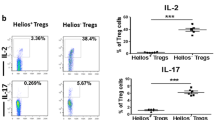Summary
Peripheral blood cells from patients with aplastic anemia were tested for their ability to release interleukin-2 (IL-2) and colony stimulating activity (CSA) before treatment. IL-2 release — as measured in the mouse thymocyte assay — was abnormally high in 18/34, and abnormally low in 10/34 patients. “Low” release was due to simultaneous release of thymocyte inhibitors. In 18 patients who achieved self-sustaining hemopoiesis after high dose immunosuppressive therapy, excess IL-2 release decreased to low levels (p<0.001), and the release of inhibitors disappeared.
In contrast, the release of CSA by patient cells — which did not correlate with peripheral blood monocyte counts — either remained high or increased to excessively high values in 24/24 patients tested before and after successful immunosuppressive treatment. Patients with stable hemopoietic grafts after bone marrow transplantation for aplastic anemia, did not release excess CSA.
It is concluded that IL-2 and CSA play opposite roles in aplastic anemia. High IL-2 release seems associated with disease activity, whereas high CSA-release appears to reflect a repair mechanism.
Similar content being viewed by others
References
Andrus L, Lafferty KJ (1982) Inhibition of T-cell activation by Cyclosporin A. Scan J Immunol 15: 449–458
Appelbaum FR, Fefer A (1981) The pathogenesis of aplastic anemia. Seminars in Hematology 18: 241–257
Bunjes D, Hardt C, Rollinghoff M, Wagner H (1981) Cyclosporin A mediates immunosuppression of primary cytotoxic T-cell responses by impairing the release of interleukin-1 and interleukin-2. Eur J Immunol 11: 657–661
Camitta BM, Storb R, Thomas ED (1982) Aplastic anemia: pathogenesis, diagnosis, treatment and prognosis. N Engl J Med 306: 645–652 and 712–718
Camitta B, O'Reilly RJ, Sensenbrenner L, Rappeport J, Champlin R, Doney K, August Ch, Hoffmann RG, Kirkpatrick D, Stuart R, Santos G, Parkman R, Gale RP, Storb R, Nathan D (1983) Antithoracic duct lymphocyte globulin therapy of severe aplastic anemia. Blood 62: 883–888
Doney KG, Weiden PL, Buckner CD et al. (1981) Treatment of severe aplastic anemia using antithymocyte globulin with or without an infusion of HLA haploidentical marrow. Exp Hematol 9: 829–834
Gale RP, Champlin RE, Feig SA, Fitchen JH (1981) Aplastic anemia: biology and treatment. Ann Int Med 95: 477–494
Gillis S (1983) Interleukin 2: biology and biochemistry. J Clin Immunol 3: 1–13
Gratwohl A, Müller M, Osterwalder B, Bannert P, Nissen C, Jeannet M, Speck B. Treatment of severe aplastic anemia with antilymphocyteglobulin and high dose methylprednisolone. Exp Hematol Vol. 10, Suppl No. 10, 1982, p. 139 (abstract)
Gluckman E, Devergie A, Poros A, Degoulet P (1982) Results of immunosuppression in 170 cases of severe aplastic anemia. Report of the European Group of Bone Marrow Transplant (EBMT). Br J Hematol 51: 541–550
Jansen J, Zwaan FE, Haak HL et al. (1982) Antithymocyte globulin treatment for aplastic anemia. Scan J Hematol 28: 341–351
Nissen C, Moser Y, Speck B (1982) Effects of human serum on the release of hemopoietic growth factors. Brit J Hematol 51: 385–390
Nissen C, Moser Y, Bürgin M, Oberholzer M, Bannert P, Corneo M, Speck B (1982) Aplastic anemia: Low production of hemopoietic growth factors predicts failure or retarded recovery after immunosuppressive treatment. Exp Hematol, Vol. 10, Suppl No. 12: 143–149
Nissen C, Moser Y, Speck B, Bendy J (1983) Hemopoietic stimulators and inhibitors in aplastic anemia serum. Brit J Hematol 54: 519–530
Nissen C, Gratwohl A, Speck B, Falkenburg F, Moser Y, Bendy J, Osterwalder B, Buser V. Aplastic anemia: hyperlsensitivity of precursor cells to complement. Exp Hematol Vol. 2 No. 6, 1984, p. 472
Nissen C, Moser Y, Speck B, Gratwohl A, Weis J. (1985) Stimulatory serum factors in aplastic anemia Part II: Prognostic significance for patients treated with high dose immunosuppression. Brit J Hematol 61: 499–512
Nissen C, Moser Y, Weis J, Speck B (1985) Stimulatory serum factors in aplastic anemia Part I: Serum “Releaser” activity for hemopoietic growth factors, a regulator? Brit J Hematol 61: 491–498
Nissen C, Gratwohl A, Osterwalder B, Speck B. Aplastic anemia: a disease of “seed” and “soil” proceedings of the European Bone Marrow Transplantation Meeting Jan. 1985. Exp Hematol (Suppl. 17) 13: 64–65
Paetkau V, Mills G, Gerhart S, Monticone V (1976) Proliferation of murine thymic lymphocytes in vitro is mediated by the Concanavalin-A induces release of a lymphokine (Costimulator). J Immunol 117: 1320–1324
Rothmann SA, Streeter RR, Bukowski RM, Hewlett JS (1982) Treatment of severe aplastic anemia with antithymocyte globulin. Exp Hematol, Vol. 10, No. 9: 809–816
Speck B, Gratwohl A, Nissen C, Leibundgut U, Ruggero D, Osterwalder B, Burri HP, Cornu P, Jeannet M (1981) Treatment of severe aplastic anemia with antilymphocyte globulin or bone marrow transplantation. Brit Med J 282: 860–863
Speck B, Gratwohl A, Nissen C, Osterwalder B, Signer E, Jeannet M (1983) Bone marrow graft versus ALG in patients with aplastic anemia. Biomedicine and Pharmacotherapy 37: 139–143
Welte K, Wang Ch, Mertelsmann R, Venuta S, Feldman S, Morre M (1982) Purification of human interleukin-2 to apparent homogeneity and its molecular heterogeneity. J Exp Med 156: 454–464
Author information
Authors and Affiliations
Additional information
This work was supported by grants of the Swiss Science Foundation 3.846.079, the Swiss Cancer League FOR 242. LR. 79 (3) and the Dr. M. Cloëtta-Foundation (Switzerland)
Rights and permissions
About this article
Cite this article
Nissen, C., Moser, Y., Weis, J. et al. The release of interleukin-2 (IL-2) and colony stimulating activity (CSA) in aplastic anemia patients: opposite behaviour with improvement of bone marrow function. Blut 52, 221–230 (1986). https://doi.org/10.1007/BF00321081
Received:
Accepted:
Issue Date:
DOI: https://doi.org/10.1007/BF00321081



